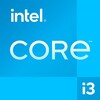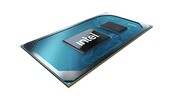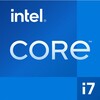Intel Core i3-1220P vs Intel Core i7-1195G7 vs Intel Core i7-1270P
Intel Core i3-1220P
► remove from comparison
The Intel Core i3-1220P is a lower mid-range Alder Lake family SoC designed for use in ultra-light, ultra-thin laptops of the more affordable flavour. It was announced in early 2022 and it has 2 performance cores as opposed to the 6 cores of the top-of-the-line i7-1280P (P-cores, Golden Cove architecture) mated to 8 efficient cores (E-cores, Gracemont architecture). The i3's P-cores are Hyper-Threading-enabled for a total of 12 threads when combined with its E-cores. The clock speeds range from 1.5 GHz to 4.4 GHz for the performance cluster and 1.1 GHz to 3.3 GHz for the efficient cluster. The shortcomings of this processor as compared with the faster Core i5-1240P are many, including the significantly slower iGPU, lower CPU core count, lower clock speeds, complete lack of the vPro features.
Architecture
The i3 is a continuation of Intel's efforts to use the ARM-developed big.LITTLE technology for its own benefit. A single "little" Alder Lake core is supposed to be as fast as a Skylake core (as found in the venerable Core i7-6700HQ among other options) which is six years old at this point. All of Core i3-1220P's CPU cores enjoy access to 12 MB of L3 cache. The integrated memory controller supports various memory types up to LPDDR5-5200, DDR5-4800, LPDDR4x-4267 or DDR4-3200; Intel suggests using no more than 64 GB of RAM, for reference. Just like the other 12th Gen Intel Core processors, this Core i3 comes with the Thread Director which is a new functionality designed to help Windows 11 decide which cores to use for what workload for best performance and efficiency possible. Hardware acceleration of AI algorithms is supported via GNA 3.0 and DL Boost (via AVX2). PCI-Express 5.0 support has not found its way into Alder Lake P processors, so users will have to be content with PCI-Express 4.0 for the time being. Four PCI-Express 4 lanes allow for a read/write rate of up to 7.9 GB/s, provided a suitably fast NVMe SSD is used.
Please note that this is not a user-replaceable CPU. It gets soldered permanently on to the motherboard (FCBGA1744 socket interface).
Performance
While we have not tested a single system built around the 1220P as of October 2023, we have tested a laptop featuring the i5-1240U, a chip with nearly the same specs (2 P-cores mated to 8 E-cores, all running at the same clock speeds as what the 1220P has). Based on that, we expect the 1220P to be just slightly ahead of the Core i5-11400H, the Core i7-1265U and also the Ryzen 5 5600U, as far as multi-thread benchmark scores are concerned. Your mileage may vary depending on how high the CPU power limits are and how competent the cooling solution of your system is.
Graphics
The built-in graphics adapter in the form of the 64 EU UHD Graphics running at up to 1.1 GHz is a slightly downgraded 80 EU Iris Xe. The latter can be found in many Alder Lake-P and Tiger Lake-UP3 processors, like a Core i5-1250P or a Core i5-1145G7, respectively. Despite the lower EU cluster count, this is still a fairly capable iGPU, loaded with modern features such as the AV1 video decoding capability and SUHD 4320p monitor support. The UHD Graphics will happily drive up to 4 monitors simultaneously, provided the laptop has the outputs required. Its gaming performance is unlikely to please the crowds, though, as it will be good for resolutions no higher than 1600x900 and Low settings only in most titles trleased in 2021 and 2022. Your mileage may vary depending on how high the Power Limits are and how capable the cooling solution of a laptop is. Fast RAM is a prerequisite for decent performance as well (the UHD Graphics has to make do with no dedicated video memory).
Power consumption
The i3's base power consumption (also known as the default TDP or Power Limit 1) is 28 W; its "minimum assured" power consumption sits at 20 W. In the meantime, the maximum Turbo power consumption (also known as the PL2) is not supposed to exceed 64 W.
This 12th generation Intel chip is built with Intel's fourth-gen 10 nm process marketed as Intel 7 for decent, as of late 2022, energy efficiency. Expect the i3 to be significantly less power-hungry (and a lot easier to cool) than all other Alder Lake-P chips because of its lower core count.
Intel Core i7-1195G7
► remove from comparison
The Intel Core i7-1195G7 is a quad-core SoC from the Tiger Lake-UP3 product family designed for thin laptops and Ultrabooks that was introduced in 2021. It integrates four Willow Cove processor cores (8 threads thanks to Hyper-Threading). The base clock (minimum) depends on the configured TDP and can range from 1.3 GHz (12 Watt TDP) up to 2.9 GHz (28 W). The Turbo on one core can reach up to 5 GHz (Turbo Boost 3.0). All cores can reach up to 4.6 GHz. The i7-1195G7 is part of the Tiger Lake UP3 refresh and is the fastest CPU of the Tiger-Lake U line.
Furthermore, Tiger Lake SoCs supports four lanes of PCIe 4, AI hardware acceleration, and the partial integration of Thunderbolt 4/USB 4 and Wi-Fi 6E in the chip.
The 1195G7 integrates the Intel Iris Xe graphics adapter with 96 EUs clocked at 400 - 1400 MHz. The GPU and CPU can together use the 12 MB of L3 cache.
Performance
The average 1195G7 in our database matches the Intel Core i5-10300H in multi-thread performance while, perhaps surprisingly, lagging behind the AMD Ryzen 3 5300U. The makes the i7 a decent lower mid-range chip, as of early 2022. It'll run most apps with virtually no delays or slowdowns which is what the vast majority of users wants.
Thanks to its decent cooling solution and a long-term CPU power limit of slightly more than 30 W, the VAIO SX14 VJS144X0111K is among the fastest laptops built around the 1195G7 that we know of. It can be about 40% faster in CPU-bound workloads than the slowest system featuring the same chip in our database, as of August 2023.
Power consumption
This Core i7 series chip has a default TDP of 12 W to 28 W, the expectation being that laptop makers will go for a higher value in exchange for higher performance. Either way, that's a tad too high to allow for passively cooled designs.
The i7-1195G7 is built with Intel's 3rd generation 10 nm process marketed as SuperFin for below average, as of early 2023, energy efficiency.
Intel Core i7-1270P
► remove from comparison
The Intel Core i7-1270P is a higher-end Alder Lake-P family CPU, an expensive 28 W part meant for use in ultra-light, ultra-thin (yet actively cooled) laptops. This CPU was announced in early 2022 and it has 4 performance cores as opposed to the 6 cores of the top-of-the-line 1280P (P-cores, Golden Cove architecture) mated to 8 efficient cores (E-cores, Gracemont architecture). The P-cores are Hyper-Threading-enabled for a total of 16 threads when combined with the E-cores. The clock speeds range from 2.2 GHz to 4.8 GHz for the performance cluster and 1.6 GHz to 3.5 GHz for the efficient cluster. Full vPro feature set is supported by this Core i7 ("Enterprise" tier, allowing for remote device management). Its shortcomings as compared with the mighty i7-1280P include the smaller L3 cache, lower core count, lower clock speeds; the performance is slated to be significantly lower as a result.
A brief look at the specifications instantly reveals this i7 series chip to be very similar to the Core i5-12600H, a more power-hungry processor targeted at gaming laptops.
Architecture
The i7 is a continuation of Intel's efforts to use the ARM-developed big.LITTLE technology for its own benefit. A single "little" Alder Lake core is supposed to be as fast as a Skylake core (as found in the venerable Core i7-6700HQ among other options) which is six years old at this point. All of an Intel Core i7-1270P's CPU cores enjoy access to 18 MB of L3 cache. The integrated memory controller supports various memory types up to LPDDR5-5200, DDR5-4800, LPDDR4x-4267 or DDR4-3200. Intel suggests using no more than 64 GB, for reference. Just like the other 12th Gen Intel Core processors, Core i7-1270P comes with Thread Director which is a new functionality designed to help Windows 11 decide which cores to use for what workload for best performance and efficiency possible. Hardware acceleration of AI algorithms is supported via GNA 3.0 and DL Boost (via AVX2). PCI-Express 5.0 support has not found its way into Alder Lake P processors, so users will have to be content with PCI-Express 4.0 for the time being. Four PCI-Express 4 lanes allow for a read/write rate of up to 7.9 GB/s, provided a suitably fast NVMe SSD is used.
Please note this is not a user-replaceable CPU. It gets soldered permanently on to the motherboard (BGA1744 socket interface).
Performance
The 12 CPU cores are not just able to outshine any outgoing quad-core Tiger Lake part, the i7-1195G7 included. The average 1270P in our database directly competes with the Ryzen 7 5825U, the Ryzen 7 7730U and the Ryzen 7 7735U, meaning this little Core i7 is fast enough to make most consumers happy as of mid 2023.
The fairly high processing power comes at a cost. A single Golden Cove core can consume more than 20 W when under heavy load. Your mileage may thus vary depending on how high the Power Limits are and how competent the cooling solution of your laptop is.
Graphics
The built-in graphics adapter in the form of the 96 EU Iris Xe running at up to 1.40 GHz has seen no change from what was built into the 11th Gen Tiger Lake-UP3 processors, like an i7-1165G7, which is hardly a downside as this iGPU is loaded with modern features such as AV1 video decoding capability and SUHD 4320p monitor support. Up to 4 monitors can be used simultaneously with this iGPU. We expect the gaming performance to be reasonably close to that of NVIDIA's MX350.
In other words, the Xe is good enough for most games at 1080p resolution / Medium settings, provided the Power Limits are high enough and the cooling solution is competent enough. Fast RAM is a prerequisite for decent performance as well (the Xe has to make do with no dedicated video memory).
Last but not the least, we discovered that the GPU utilization when playing YouTube UHD 2160p60 videos is higher than it was with Tiger Lake chips.
Power consumption
The i7's base power consumption (also known as the default TDP or Power Limit 1) is 28 W, with 64 W being its maximum Turbo power consumption (also known as the PL2). As for the "Minimum Assured" power consumption, Intel's guidelines mention 20 W. All in all, an active cooling solution is a must for such a chip.
The CPU is built with Intel's fourth-gen 10 nm process marketed as Intel 7 for decent, as of late 2022, energy efficiency. It's still a rather power-hungry CPU; a single P-core will happily consume more than 20 W when under heavy load. A couple of the higher-end 7 nm U-class AMD Ryzen 5000 chips are not nearly as power-hungry while delivering similar or higher performance levels.
| Model | Intel Core i3-1220P | Intel Core i7-1195G7 | Intel Core i7-1270P | ||||||||||||||||||||||||||||||||||||||||||||||||||||||||||||||||||||||||||||||||
| Series | Intel Alder Lake-P | Intel Tiger Lake | Intel Alder Lake-P | ||||||||||||||||||||||||||||||||||||||||||||||||||||||||||||||||||||||||||||||||
| Codename | Alder Lake-P | Tiger Lake-UP3 | Alder Lake-P | ||||||||||||||||||||||||||||||||||||||||||||||||||||||||||||||||||||||||||||||||
| Series: Alder Lake-P Alder Lake-P |
|
|
| ||||||||||||||||||||||||||||||||||||||||||||||||||||||||||||||||||||||||||||||||
| Clock | 1100 - 4400 MHz | 2900 - 5000 MHz | 1600 - 4800 MHz | ||||||||||||||||||||||||||||||||||||||||||||||||||||||||||||||||||||||||||||||||
| L1 Cache | 928 KB | 320 KB | 1.1 MB | ||||||||||||||||||||||||||||||||||||||||||||||||||||||||||||||||||||||||||||||||
| L2 Cache | 9.5 MB | 5 MB | 10 MB | ||||||||||||||||||||||||||||||||||||||||||||||||||||||||||||||||||||||||||||||||
| L3 Cache | 12 MB | 12 MB | 18 MB | ||||||||||||||||||||||||||||||||||||||||||||||||||||||||||||||||||||||||||||||||
| Cores / Threads | 10 / 12 | 4 / 8 | 12 / 16 | ||||||||||||||||||||||||||||||||||||||||||||||||||||||||||||||||||||||||||||||||
| TDP | 28 Watt | 28 Watt | 28 Watt | ||||||||||||||||||||||||||||||||||||||||||||||||||||||||||||||||||||||||||||||||
| Technology | 10 nm | 10 nm | 10 nm | ||||||||||||||||||||||||||||||||||||||||||||||||||||||||||||||||||||||||||||||||
| max. Temp. | 100 °C | 100 °C | 100 °C | ||||||||||||||||||||||||||||||||||||||||||||||||||||||||||||||||||||||||||||||||
| Socket | BGA1744 | BGA1449 | BGA1744 | ||||||||||||||||||||||||||||||||||||||||||||||||||||||||||||||||||||||||||||||||
| Features | DDR4-3200/LPDDR4x-4266/DDR5-4800/LPDDR5-5200 RAM, PCIe 4, Thread Director, DL Boost, GNA, MMX, SSE, SSE2, SSE3, SSSE3, SSE4.1, SSE4.2, AVX, AVX2, BMI2, ABM, FMA, ADX, SMEP, SMAP, EIST, TM1, TM2, Hyper-Threading, Turbo, SST, AES-NI, RDRAND, RDSEED, SHA | DDR4-3200/LPDDR4x-4266 RAM, PCIe 4, 4 GT/s, DL Boost, GNA, MMX, SSE, SSE2, SSE3, SSSE3, SSE4.1, SSE4.2, AVX, AVX2, AVX-512, BMI2, ABM, FMA, ADX, SMEP, SMAP, EIST, TM1, TM2, HT, Turbo, SST, AES-NI, RDRAND, RDSEED, SHA | DDR4-3200/LPDDR4x-4266/DDR5-4800/LPDDR5-5200 RAM, PCIe 4, Thr. Director, DL Boost, GNA, Rem. Platf. Erase, MMX, SSE, SSE2, SSE3, SSSE3, SSE4.1, SSE4.2, AVX, AVX2, BMI2, ABM, FMA, ADX, SMEP, SMAP, EIST, TM1, TM2, HT, Turbo, SST, AES-NI, RDRAND, RDSEED, SHA | ||||||||||||||||||||||||||||||||||||||||||||||||||||||||||||||||||||||||||||||||
| iGPU | Intel UHD Graphics 64EUs (Alder Lake 12th Gen) ( - 1100 MHz) | Intel Iris Xe Graphics G7 96EUs (400 - 1400 MHz) | Intel Iris Xe Graphics G7 96EUs ( - 1400 MHz) | ||||||||||||||||||||||||||||||||||||||||||||||||||||||||||||||||||||||||||||||||
| Architecture | x86 | x86 | x86 | ||||||||||||||||||||||||||||||||||||||||||||||||||||||||||||||||||||||||||||||||
| Announced | |||||||||||||||||||||||||||||||||||||||||||||||||||||||||||||||||||||||||||||||||||
| Manufacturer | ark.intel.com | ark.intel.com | ark.intel.com |


 Deutsch
Deutsch English
English Español
Español Français
Français Italiano
Italiano Nederlands
Nederlands Polski
Polski Português
Português Русский
Русский Türkçe
Türkçe Svenska
Svenska Chinese
Chinese Magyar
Magyar
